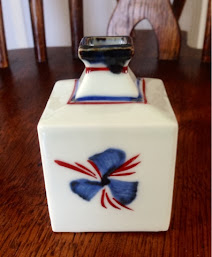Tobeyaki is the pottery of Ehime Prefecture. It is usually a white porcelain with indigo blue arabesque design. It oft times has a bit of red incorporated in the design as well. It was founded in 1777. There are over 90 kilns in the Tobe area.
Old Tobe Yaki is much different than what is produced today. They used to produce Tokkuri, some rather rough, others of the sometsuke variety. Some of the sometsuke are often confused with similar products made in Imari.
The wares of the Taisho period were often made with patterned stencils. Tobe wares dwindled in the early Showa period, but were revitalized in 1953. Although Tobe ware usually is recognized by the thick arabesque designs, they also produce other styles.
Some common attributes of Tobe ware is the thickness, rounded rims, simplicity of design and the thick brush arabesque motifs. Tobe ware is noted for its ability to showcase food through it's simplicity. Modern Tobe ware also includes a patchwork style.
(Notes taken from an NHK World presentation on Tobe ware).
 |
| This was made at least 30 years ago. There is no artist mark. |
Tobe Shuzan
I recently found out about a less known Tobe ware. It has a carved out design, a 3D relief on the side. It appears that there was a time when this style was popular in various regions of Japan. I will keep my eye out to try to find a piece to share.
Tobe Yaki Namiroku Gama 砥部焼 波六窯
A helpful link in Japanese for the Tobe Kilns:
http://www.tobeyaki.org/kamamoto.html
http://www.tobeyaki.org/kamamoto/001.htm














I recently purchased this Tobe Yaki Namiroku Gama vase, and would love to know what time period it was made in, and if it has any value. -5 1/4 inches tall
ReplyDeleteIt is vintage...perhaps 60-70 years old....not positive. I know the kiln was making wares into the 1970’s at least. I do not give values as I am not a licensed appraiser. Value in essence is in the eye of the beholder. That being said, I see simliar ones being sold on Japanese auction sites from approximately $20-30. It is more valuable if the work box is included.
ReplyDelete*wood box not work box
ReplyDelete